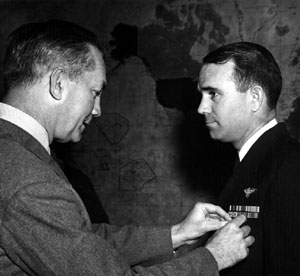 Lieutenant Carter L. "Pappy" Wilson, Jr. Lieutenant Carter L. "Pappy" Wilson, Jr.
Born in Louisville, Kentucky on December 9, 1915
An engineering graduate of Vanderbilt University, he entered the Navy as an Aviation Cadet at the St. Louis Naval Air Station in December 1941. Further flight training took place at NAS Pensacola and he graduated with the rank of Ensign in August 1942. After graduation Pappy served on temporary duty as an Officer Flight Student at NAS Norfolk, Fort Lauderdale, and Glenview, Illinois.
He married the former Betty Ann Millard of Louisville on January 20, 1943. They had three sons. Promoted to Lieutenant (jg) he was assigned to Torpedo Squadron 16 as Assistant Engineering Officer from June 1943 to November 1944 while temporarily assigned as a Combat Team Leader at NAS Miami and Glenview, Illinois.
While with VT-16 aboard the USS Lexington (CV 16), he was recommended by Secret letter 21 October 1943, for an Air Medal for actions as a member and leader of the first group of planes to strike Wake Island in total darkness on October 5 and 6, 1943. No action appears to have been taken on the recommendation and he was later awarded the Distinguished Flying Cross "For heroism and extraordinary achievement . . . against enemy Japanese forces at Palau Island, March 30 and 31, 1944, and an Air Medal "for meritorious achievement . . . against enemy Japanese forces in the Marianas Islands from June 12 to 25, 1944. Pappy was a "plank holder" on the Lexington.
Promoted to the rank of Lieutenant, on Christmas Day 1944 he was assigned to Torpedo Squadron 31 as Executive Officer, aboard the USS Belleau Wood (CVL 24) where he was awarded the Navy Cross and Gold Stars in lieu of a second and third Air Medal for actions against the Japanese homeland.
Medals Awarded to Lieutenant Carter L. Wilson
Pappy was a member of the "Goldfish Club," having ditched his torpedo bomber three times during the war. But his original crew stayed with him during the entire conflict and it was not until 1958 when doctor's dug a small piece of shrapnel from his knee. After the war, he transferred from the Naval Reserve to the Regular Navy and in December 1945 was assigned of the Bureau of Aeronautics in Washington, D.C. where he worked in the Special Design Branch as Project and Budget Officer for the Pilotless Aircraft Division.
In 1947 he attended Postgraduate School in Annapolis and MIT, receiving his Masters in Aeronautical Engineering in 1950. He returned to a short aviator training course in Key West and was assigned to Attack Squadron 25 (VA 25) aboard the U.S.S. Franklin D. Roosevelt with cruises to Guantanomo Bay and the Mediterranean. Returning from sea duty in 1951, Pappy was promoted to Lieutenant Commander and assigned to Armament Test at Patuxent River, Maryland where he served as project officer, test pilot and maintenance officer. Transferred to the U.S.S. Bennington (CVA 20) after the disastrous fire, he served during her retrofit at the Brooklyn Navy Yard as Assistant Weapons Officer and Special Weapons Coordinator, later taking her to the Bennington's new home port at NAS North Island (Coronado, California) where he was promoted to Commander in 1956.
He was once again assigned to the Bureau of Aeronautics in Washington, D.C. where he was the head of the Fighter Operations Systems Branch until 1959 when he was assigned as Executive Officer of Air Development Squadron 5 (VX 5) at Naval Ordinance Test Station (NOTS) in China Lake, California. In August 1961 he was assigned as Executive Office, NAS Agana, Guam and in 1963 as Range Control Office at the Pacific Missile Range, Pt. Mugu, California.
Pappy retired from the Navy in June 1965 and moved to Litchfield Park, Arizona, where he worked as a military project liaison with Goodyear Aerospace, later as a Quality Control Engineer with AT&T at their Cable Manufacturing Plant, retiring in 1980. Commander Wilson passed away December 24, 1995 at his home in Litchfield Park, Arizona.
|

